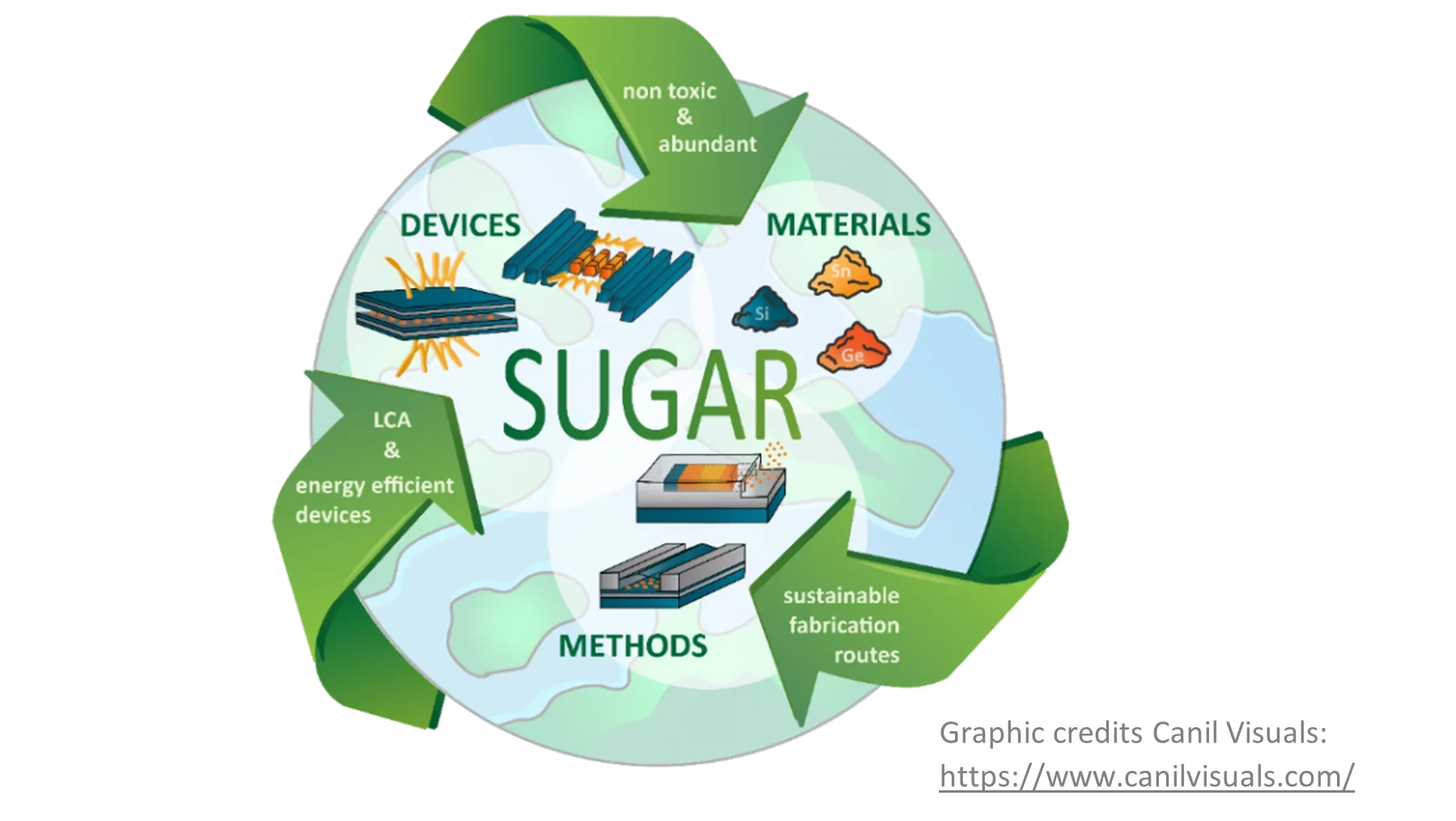The integration of photonics and electronics on the same chip has been a long-standing goal, as it promises higher performance in data transmission, bandwidth, operation speed, and potentially, energy efficiency. Information and Communication Technology (ICT) and electronic Entertainment & Media (E&M) consume over 5% of global electricity, making energy efficiency crucial at all stages.
Silicon CMOS electronics provide a high-performance, low-cost platform for computation with billions of transistors. Photonics, which manipulates light, plays a crucial role in the advancement of electronics and optoelectronics, which contribute to economic growth and societal well-being. Silicon is an ideal material for waveguiding in the near IR (NIR) and light detection in the visible light spectrum (VIS). However, due to its indirect bandgap, it is unsuitable for light emission. Current approaches use silicon for light transmission and integrate active optical functionality with Ge-based photodetection and compound semiconductors (III-Vs) for light emission.
The Sustainable Group-IV Active Photonics Research (SUGAR) project aims to develop a more sustainable photonics platform, focusing on group IV elements (Si, Ge, Sn) that are non-toxic and abundant. The proposal emphasizes sustainability throughout the entire device life-cycle, incorporating life-cycle analysis (LCA) from extraction to end-of-life. SUGAR's goals include:
- Developing a semiconductor platform based on high-quality SixGe1-x and Ge1-xSnx, enabling active optoelectronic devices on silicon with reduced environmental impact compared to compound semiconductors III-Vs.
- Creating innovative device designs that enable dimensional scaling, competitive performance and energy efficiency, combined with reduced environmental impact
- Incorporating sustainability at all fabrication levels, from materials usage to cleanroom processing, laying the groundwork for high-performance, sustainable photonics and enabling eco-design and full LCA of components.
- Developing an LCA methodology for semiconductor technology, which is currently in its infancy compared to other sectors.
SUGAR aims to impact semiconductor growth and device technology by exceeding the current state-of-the-art in group-IV photonic devices. This will be achieved through the combined efforts of two teams specializing in epitaxial materials growth and nanoscale integrated photonics. By emphasizing sustainability in the device life-cycle, SUGAR intends to establish new methodologies in sustainable semiconductor manufacturing, essential for a future green economy.
The project will also integrate these learnings into teaching and joint workshops, raising awareness on high-performance devices that address environmental concerns.
Project impact
SUGAR aims to revolutionize on-chip data transmission by,
- Enabling next-generation photonics with less power consumption and dissipation
- Developing more ecologically sustainable fabrication processes
- Adding light emission and detection capabilities based on direct bandgap GeSn to Si photonics platforms
- Providing thorough analysis of process sustainability and solutions for improvement
- Creating methodologies applicable to other areas of the micro/nano-electronic industry
SUGAR is an interdisciplinary project involving three major academic institutions in Switzerland: PSI, EPFL, and ETHZ. SUGAR is organized into distinct areas of expertise and tasks, each crucial to achieving the project's goals. EPFL focuses on developing the materials platform, while PSI is responsible for device implementations based on EPFL's materials. ETHZ collaborates with both EPFL and PSI to address sustainability in materials growth and device fabrication. All parties work together to evaluate the energy-efficiency potential of the produced devices and conduct life-cycle analysis, drawing from their individual expertise.
SUGAR project
Head of Laboratory for Nano and Quantum Technologies (LNQ)
PhD student
External Advisors
Post-doc Integrated Photonics and Nanoelectronics
-
Choi H, Scherrer M, Kim S, Seo S, Moselund K, Lee CW
Zak phase of a 1D topological photonic crystal by finite-difference time-domain simulation
In: Proceedings of the international conference on numerical simulation of optoelectronic devices (NUSOD). IEEE Computer Society; 2024:87-88. https://doi.org/10.1109/NUSOD62083.2024.10723420
DORA PSI -
Iadanza S, Rihani M, Martinez CO, Scherrer MA, Georgiev V, Schmid H, et al.
Ultra-low temperature characterization of fully- integrated iii-v photodetectors for quantum networks
In: IEEE international electron devices meeting. Technical digest - international electron devices meeting, IEDM. Piscataway: Institute of Electrical and Electronics Engineers; 2024. https://doi.org/10.1109/IEDM50854.2024.10873440
DORA PSI -
Martinez-Oliver C, Scherrer M, Iadanza S, Schmid H, Moselund K, Georgiev V
Simulation and fabrication of monolithic III-V photodetectors on Si: the role of growth facets and localization of heterojunctions
IEEE Transactions on Electron Devices. 2024; 71(10): 6124-6130. https://doi.org/10.1109/TED.2024.3437333
DORA PSI -
Martinez CO, Scherrer M, Iadanza S, Wen P, Tiwari P, Sousa M, et al.
Monolitx of III-V photodiodes and emitters on silicon
In: European conference on optical communications. Vol. 2023. IET conference proceedings. London: Institution of Engineering and Technology; 2023:756-759. https://doi.org/10.1049/icp.2023.2328
DORA PSI
















